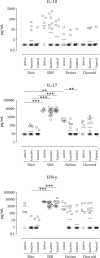Interleukin-17 production and T helper 17 cells in peripheral blood mononuclear cells in response to ocular lysate in patients with birdshot chorioretinopathy
- PMID: 24379648
- PMCID: PMC3874049
Interleukin-17 production and T helper 17 cells in peripheral blood mononuclear cells in response to ocular lysate in patients with birdshot chorioretinopathy
Abstract
Purpose: To determine the cytokine response to ocular lysates of peripheral blood mononuclear cells (PBMCs) from patients with birdshot chorioretinopathy (BSCR).
Methods: In the PBMCs of 19 patients with BSCR, T cell cytokine production in response to human retina and choroid lysates was analyzed with flow cytometry and compared to the responses against skin lysates. Five patients had active disease and had not yet been treated (naïve to systemic therapy); 14 patients had either immunomodulatory therapy (IMT) or inactive disease (referred as inactive/IMT). The PBMCs of 11 HLA-A29-positive healthy individuals were used as controls.
Results: The levels of interleukin-17 (IL-17) in supernatant of cultures stimulated with retina lysate were higher in patients with active BSCR compared to the HLA-A29 positive controls. The levels of other T cell cytokines (IL-10 and interferon-γ [IFN-γ]) in PBMC cultures did not change significantly after stimulation with ocular lysate. The frequency of CD4(+) IL-17(+) (T helper 17 [Th17]) T cells but not of CD4(+) IFN-γ (Th1) T cells was elevated in the PBMCs of patients with active BSCR stimulated by retina lysates compared to skin lysates.
Conclusions: Our data demonstrate that PBMCs exhibit an IL-17-mediated immune response to retina lysate in patients with active disease naïve to systemic therapy. This is accompanied by the enrichment of IL-17-producing CD4(+) T cells. These findings support the current concept of chronic Th17-cell mediated inflammation and provide evidence that links the Th17 signatures to ocular-specific immune responses in BSCR.
Figures


Similar articles
-
Detection of choroid- and retina-antigen reactive CD8(+) and CD4(+) T lymphocytes in the vitreous fluid of patients with birdshot chorioretinopathy.Hum Immunol. 2014 Jun;75(6):570-7. doi: 10.1016/j.humimm.2014.02.012. Epub 2014 Feb 12. Hum Immunol. 2014. PMID: 24530754
-
The immunopathogenesis of birdshot chorioretinopathy; a bird of many feathers.Prog Retin Eye Res. 2015 Jan;44:99-110. doi: 10.1016/j.preteyeres.2014.11.003. Epub 2014 Nov 26. Prog Retin Eye Res. 2015. PMID: 25434765 Review.
-
Elevated Serum Immune Mediators and Subclinical Inflammation in HLA-A29-associated Birdshot Chorioretinopathy.Ocul Immunol Inflamm. 2016 Dec;24(6):647-652. doi: 10.3109/09273948.2015.1057601. Epub 2015 Dec 8. Ocul Immunol Inflamm. 2016. PMID: 26645126
-
Interleukin 21, interleukin 23, and transforming growth factor β1 in HLA-A29-associated birdshot retinochoroidopathy.Am J Ophthalmol. 2013 Aug;156(2):400-406.e2. doi: 10.1016/j.ajo.2013.03.004. Epub 2013 Apr 23. Am J Ophthalmol. 2013. PMID: 23622563
-
HLA-A29 and birdshot chorioretinopathy.Ocul Immunol Inflamm. 2011 Dec;19(6):397-400. doi: 10.3109/09273948.2011.619295. Ocul Immunol Inflamm. 2011. PMID: 22106906 Review.
Cited by
-
Destructive inflammatory reaction after an autologous retinal pigment epithelium and choroid transplantation: no detection of an auto-immune response.J Ophthalmic Inflamm Infect. 2022 Aug 26;12(1):27. doi: 10.1186/s12348-022-00305-2. J Ophthalmic Inflamm Infect. 2022. PMID: 36018390 Free PMC article.
-
Birdshot Chorioretinopathy: A Review.J Clin Med. 2022 Aug 16;11(16):4772. doi: 10.3390/jcm11164772. J Clin Med. 2022. PMID: 36013011 Free PMC article. Review.
-
Birdshot chorioretinopathy: current knowledge and new concepts in pathophysiology, diagnosis, monitoring and treatment.Orphanet J Rare Dis. 2016 May 12;11(1):61. doi: 10.1186/s13023-016-0429-8. Orphanet J Rare Dis. 2016. PMID: 27175923 Free PMC article. Review.
-
High-Dimensional Profiling Reveals Heterogeneity of the Th17 Subset and Its Association With Systemic Immunomodulatory Treatment in Non-infectious Uveitis.Front Immunol. 2018 Oct 31;9:2519. doi: 10.3389/fimmu.2018.02519. eCollection 2018. Front Immunol. 2018. PMID: 30429855 Free PMC article.
-
Aberrant leukocyte telomere length in Birdshot Uveitis.PLoS One. 2017 May 1;12(5):e0176175. doi: 10.1371/journal.pone.0176175. eCollection 2017. PLoS One. 2017. PMID: 28459868 Free PMC article.
References
-
- Monnet D, Brezin AP. Birdshot chorioretinopathy. Curr Opin Ophthalmol. 2006;17:545–50. - PubMed
-
- Shah KH, Levinson RD, Yu F, Goldhardt R, Gordon LK, Gonzales CR, Heckenlively JR, Kappel PJ, Holland GN. Birdshot chorioretinopathy. Surv Ophthalmol. 2005;50:519–41. - PubMed
-
- Nussenblatt RB, Mittal KK, Ryan S, Green WR, Maumenee AE. Birdshot retinochoroidopathy associated with HLA-A29 antigen and immune responsiveness to retinal S-antigen. Am J Ophthalmol. 1982;94:147–58. - PubMed
-
- Priem HA, Kijlstra A, Noens L, Baarsma GS, De Laey JJ, Oosterhuis JA. HLA typing in birdshot chorioretinopathy. Am J Ophthalmol. 1988;105:182–5. - PubMed
Publication types
MeSH terms
Substances
LinkOut - more resources
Full Text Sources
Other Literature Sources
Research Materials
